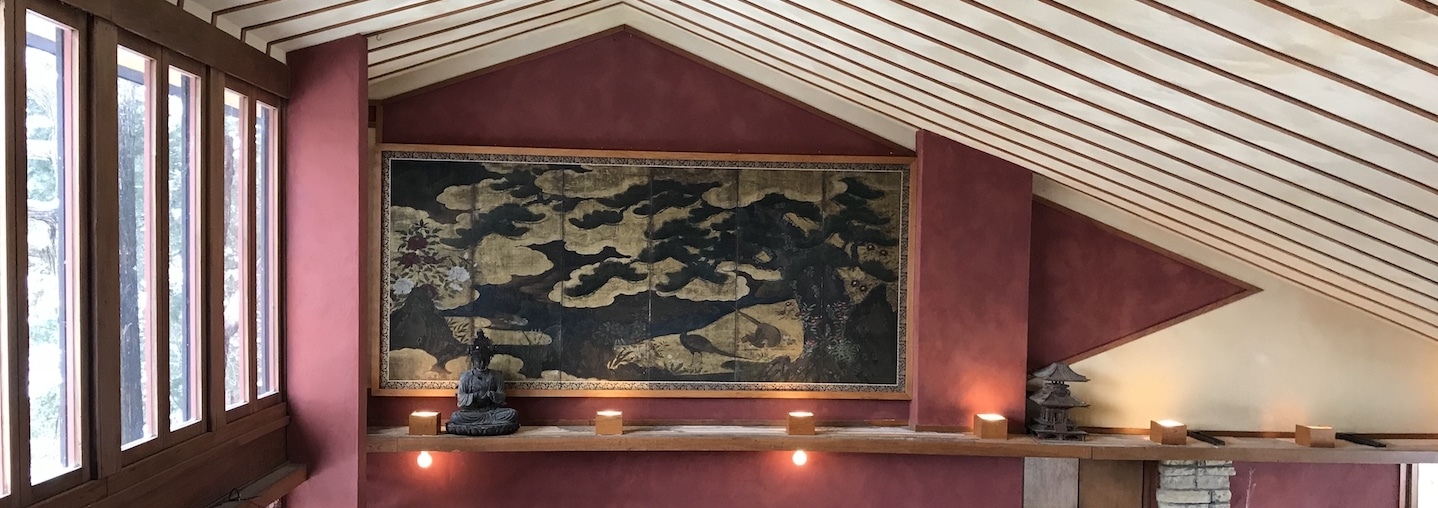
Conservation of Japanese Screen at Taliesin
Tru Vue | Mar 1, 2018
During the cold winter months, when tours were closed to the public at Taliesin in Spring Green, Wisconsin, the Frank Lloyd Wright Foundation and sister organization, Taliesin Preservation, partnered to complete a project that is set to be a major highlight on the tour path in the 2018 season.
Following its recent conservation, updated framing and new glazing, the Japanese screen “Pine Tree with Pheasants and Ducks” returns to Frank Lloyd Wright’s Drafting Studio at Taliesin in Spring Green, Wisconsin. A National Historic Landmark that was once Wright’s home and architectural studio, Taliesin houses an extensive collection of works that he purchased throughout his life.
“Frank Lloyd Wright’s knowledge of and appreciation for Japanese culture and art are well known. He was a prolific collector of woodblock prints, screens, scrolls, ceramics and sculpture throughout his life, filling the living spaces and the vault at Taliesin with wonderful treasures,” says the foundation’s Director and Curator of Collections Margo Stipe.
Of the dozens of screens in the collection, “Pine Tree with Pheasants and Ducks” is one of six in the Kano School tradition in the Wright collection, most of which date to the 17thcentury Japan (Edo period 1603-1868). Stipe elaborates, “These screens are large, bold, and gorgeously decorative, and Wright admired them for their flat abstracted patterns of pine trees, rocks, birds and flowers set against a gold ground.”
The Conservation Campaign at Taliesin: From the 1980s to Today
The conservation treatment of “Pine Tree with Pheasants and Ducks” is part of a multi-phase project led by the Frank Lloyd Wright Foundation’s collections and preservation staff, Taliesin Preservation, Inc. (TPI) and T.K. McClintock of Studio TKM Conservation of Fine Art and Historic Works on Paper. McClintock has been involved with the foundation’s conservation programs for decades, including the surveys of the Japanese screens and Chinese paintings begun in 1980s. At that point, the paintings were becoming markedly compromised in condition, appearance and potential longevity, necessitating the removal of some of them to storage. “Pine Tree with Pheasants and Ducks” were among those that were de-installed at the time.
“Years of exposure rendered many of the screens in need of conservation and the most important, including this one, were conserved in the mid-1990s for an exhibition on Wright and Japanese art,” explains Stipe. “Pine Tree with Pheasants and Ducks” and other works traveled to Phoenix, Los Angeles, several venues in Japan, and finally to New York, after which they were stored until they could be safely returned to the walls.
A total of 11 screens and panels are now being conserved and remounted, room-by-room. Throughout their history at Taliesin, many of the screens were rotated among different locations, while others remained in situ, where the dimensions were specifically configured.
Historic photographs document that Japanese and Chinese screens were on display in most of the living spaces at Taliesin during Wright’s lifetime. “Pine Tree with Pheasants and Ducks” appears in photos at least as early as 1929, shown as installed in the studio, where it is now again on display.
To restore this painting and five of the others back to life, Studio TKM donated more than two years and 3,000 hours of its conservation services. “The Japanese screens are very complex and fragile assemblies,” describes McClintock, who serves on the Boards of Trustees of both the Foundation and TPI. “There can be gold leaf application in the background and low-relief gesso applications and course pigments, such as the malachite used in the green foliage.”
He elaborates, “They differ very much from Western paintings in that they were not displayed flat against the wall. They were part of the domestic environment, displayed upright in a zigzag fashion, dynamic in nature, with quite large surface areas. They are constructed of lattice wood cores covered with Japanese paper, characteristic bi-fold paper hinge and silk brocade borders or decorative papers on the back.”
Frank Lloyd Wright adapted a strategy of accommodation when the screen paintings he wished to mount on the walls could not be maintained in their original formats. Folding screens that became separated were displayed with decorative strips between them, or removed from their supports altogether, and re-attached to individual wooden panels.
Emphasizing the caution inherent to any conservation project, McClintock says, “The conservation of Asian works is a distinct specialty. Compromises are identified and risks of treatment mitigated with particular focus on the sensitivity of the media. This requires technical capability guided by connoisseurship.”
Protective Presentation
“Pine Tree with Pheasants and Ducks” is the seventh of the 11 Japanese screens and Chinese paintings to be reinstalled at Taliesin. Following the artwork’s conservation, each screen also is custom framed and glazed using Tru Vue® Optium Museum Acrylic®, a shatter- and abrasion-resistant, anti-static, anti-reflective material that filters up to 99 percent of damaging UV light.
To hang the piece, a structural aluminum L-channel was used for the top and bottom rails. The lower edge of the bottom channel was painted black, which appears as a shadow line to the casual observer. The aluminum is lagged into the wall framing and then covered by Cypress trims. Old growth Cypress was sourced from Louisiana through W.P. Barber Lumber Company, Inc. An amber shellac finish brought the frame as close as possible to matching the existing, adjacent woodwork at Taliesin.
“Wright’s spaces are noted for their extraordinary light introduced through extensive windows, glass doors and clerestories, so the positioning of Tru Vue Optium Museum Acrylic glazing over the screens is critical to protecting them from UV light penetration and dust,” praises Stipe.
McClintock also credits Tru Vue as part of the conservation solution: “This would not have been possible without Tru Vue. The UV protection, scratch resistance and anti-reflective surface are what made it possible for the original paintings to be displayed in a venue with an active visitors program. It’s a terrific product.”
Ryan Hewson, preservation manager at the Frank Lloyd Wright Foundation, shares this appreciation as well. “In this particular screen, Optium helps to enhance the contrast of the almost inky black blues and the lighter colors. This results in some of the more delicate details being more apparent than they would be. It is hard to describe, but having seen the screen with and without glazing, I can see that it is more vivid with than without. Details appear more crisp.”
Seamed for Size
Measuring 64.7 inches by 144.5 inches, “Pine Tree with Pheasants and Ducks”, is one of the larger works being reinstalled at Taliesin during a multi-phase conservation campaign. Slightly larger than the full-sheet dimensions of Optium Museum Acrylic (which measures 72 inches by 120 inches), it required bonding two sheets end-to-end in a process SmallCorp developed called “seaming.”
SmallCorp’s sales and marketing manager Michael Dunphy explains, “The seam won’t affect the material’s performance or quality. You will be able to see it if you look for it, but even then it’s hard to see. On works of this size, the viewer typically stands some distance back, making it very difficult to see the seam. In this case, we placed the seam in the center of the glazing, so that it aligns with the space between the hinged panels, which is already an existing vertical line on the screen.”
Visit to View
In addition to “Pine Tree with Pheasants and Ducks” returning to the Studio, the conservation, framing, glazing and re-installation has been completed for:
“Pine with Cherry Blossoms and Birds” on the Loggia South Wall
“Figures in a Mountain Landscape” on the Loggia North Wall
“Congress of Birds” in the Guest Bedroom
“Tale of Ise or Genji” in Mrs. Wright’s Bedroom
“Ink Landscape” in Mr. Wright’s Bedroom
“Court Scene” in the Loggia Alcove
“Silk Cultivation of the Four Seasons” in the Living Room behind the dining room table
“Autumn/Winter” in the Living Room Alcove is scheduled for reinstallation in April 2018. Estimated completion of “Chinese Sage” at the top of the Loggia Stairs is estimated for Spring 2019. “Kyoto Street Scene” above the bed in Mr. Wright’s Bedroom is planned as part of a larger restoration project anticipated for 2023.
A digital unveiling of “Pine Tree with Pheasants and Ducks” occurred in February. An exclusive group of Valentine’s Day dinner guests, Taliesin’s residents and its staff are among the few who have seen the reinstalled piece in person. Hewson says, “People have commented on how well the installation was done and how great the final product looks. Other people have commented on the beauty of the screen.”
Watch the installation below.



